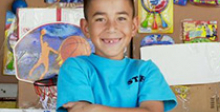Internal mini form
Contact Us Today
A person with Cerebral Palsy may feel as though finding acceptance from others has been a difficult task. But once the first step of accepting what’s different and unique about oneself is achieved, a person opens themselves up to greater acceptance.
Ten tips for individuals with Cerebral Palsy
It’s not easy to move through life with a disability. If a person has Cerebral Palsy, the aforementioned statement may be an understatement.
Physically, the world seems to have been built for someone else; people who don’t have to worry about whether a mailbox, a computer mouse, or a doorknob is within reach or functionality. The physical issues borne from disability as applied to everyday life can be daunting, but there are other aspects of life that some feel are beyond one’s grasp. One of these is acceptance.
Accepting one’s condition – and finding acceptance from others – comes easily for some people with disabilities. This can be the case when the right combination of encouragement, opportunity, accomplishment, and personality are present. For others, achieving acceptance from others at school, in the workplace, or socially feels like an uphill battle.
It may seem trite, or pie-in-the-sky, but there is no obstacle that cannot be overcome. Here are 10 ways that a person with Cerebral Palsy can replace feelings of isolation with feelings of connectedness.
1. Change your mind.
Creating an atmosphere of self-acceptance often means changing tapes engrained in the mind that play messages that are counter-productive. A person with disabilities may have varying levels of control in terms of their daily activities and abilities, but he or she will always control how they perceive themselves and that is projected onto others.
Changing one’s attitude means not letting the perceptions of others stand in the way of goals. It means taking responsibility for situations that are not healthy and implementing changes that will improve one’s outlook.
It also means digging deep to determine what a disability gives to a person, as opposed to what it takes away.
Is a person’s ability to listen to others, be a good friend, or participate in intellectual work heightened by a disability? Are his or her powers to empathize with people in difficult situations enhanced because of his or her perspective? Those with disability are often kind, sensitive, loving and compassionate, which are qualities others often gravitate towards, not away from.
2. Get online.
A good first step to reaching out of one’s shell is to get online. Since the advent of the Internet, several disability and Cerebral Palsy forums have been created to help people connect with one another. Community forums have also turned up on social media, such as Facebook and Twitter, which can help people with disabilities communicate with others, and connect with others so they can explore feelings with individuals with similar interests. With today’s DynaVox, Tobii, and text-to-speech technology furthers a non-verbal individual’s ability to communicate with others with relative ease.
3. Don’t be afraid to speak up.
In workplace settings, or even at home, people with disabilities often feel uncomfortable about speaking up and contributing to a conversation or discussion. The fear is that the perception of co-workers or others regarding one’s competency will be negative. As with able-bodied peers, most don’t wait to be invited to the party, but instead work towards striking up a conversation with those they would like to join. Being proactive may open doors to friendships and group acceptance.
4. Take part in activities that encourage connectedness.
It can be excruciatingly difficult for a person to begin to socialize as an adult. This is true for all people of age, not just those with special needs. It’s a bold step to eliminate feelings of isolation because of the prospects of being around others. Getting out and about will also help people with disabilities explore their passions – sports, arts, cinema, books, food, or anything else – among people with whom they have something in common.
5. Put other people at ease.
People without disabilities sometimes aren’t sure about how to approach a person with disabilities. They’re not sure if they will say or do the wrong things. Generally, they don’t want to do anything that will embarrass someone or make them feel diminished. And, sadly, more often than not their reaction is to shy away. Sharing experiences and opinions with others without disabilities helps people form bonds. Be prepared to initiate dialogue about your condition, your abilities and your challenges to bridge the comfort gap.
Be prepared to take the “elephant out of the room” by anticipating why the other person may be reluctant to talk, and bridge the knowledge gap for them. For example, “Hi, my name is Sandy, do you mind if I join you? I’m non-verbal which means I have to talk through this computer, but other than that I’m much like you. Do you like attending book signings?” This opens the door for the other person to feel comfortable to ask you questions and strike up dialogue with ease, while creating normal dialogue.
6. Choose not to identify yourself by your disability.
When a person with a disability sees him or herself in a way that is limited to what they can’t do, it’s shortchanging not only oneself, but everyone else who may enjoy the person’s company. A person with Cerebral Palsy may benefit to take note of their other attributes, and repeat them over and over again.
“I am handsome.”
“I am funny.”
“I am talented.”
“I am resourceful.”
Too often, people define themselves only in terms of their abilities and achievements, but all of us are more than the sum of our parts. Gaining a sense of self can be a challenge for people with disabilities. Having a disability is a part of who they are, not what they are. They are not Cerebral Palsy, for example.
A person can have several identities depending on whom they are with. In a family setting, a person with disabilities can be a provider. In an organization, he or she can be a subject specialist. A person may have a disability, but the disability is not part of the person’s identity.
The beauty of a person’s identity is that it evolves based on a person’s stage of life and experiences. It’s something every person must determine for his or herself – it can never be defined by someone else.
7. Don’t feel guilty.
If a person feels that they may be responsible for their disability, it might be affecting how he or she sees themselves. When a person has Cerebral Palsy, however, it is not their fault. If an individual has not made peace with their condition, he or she may also feel guilty. In all cases, guilt is a waste of time that can be better spent finding ways to improve one’s life.
8. Be empowered to act.
Being empowered means taking responsibility for one’s health and happiness. People with disabilities may have trouble with the notion of taking control of their lives, but doing so is an important step to achieving acceptance. A person needs to do whatever they can to harness self-confidence and build self-esteem. If a person needs to seek assistance through therapy to do so, he or she should embark on that as soon as possible to free them of self-defeating thoughts. Being assertive and feeling good about oneself is one of the tools people with disabilities need to move forward; it’s importance cannot be overstated. Social therapists are also helpful in providing guidance and direction.
9. Embrace differences.
People with disabilities know that they’re different on the surface, and the same as others inside. Accepting physical differences can be difficult, even if a person has lived with a disability for their entire life. Strengths and weaknesses are a big part of who a person is; accepting those factors is part of having a healthy self-image.
People often pick up on how a person feels about themselves. If a person shows a lack of regard for his or herself, others may do the same. We often hear the adage “treat others as you would like to be treated.” But another adage is equally valuable: “Treat yourself as you would like others to treat you.”
10. Overcome fear and uncertainty.
Part of overcoming fear and uncertainty is to understand what it means to be normal. There is a philosophy amongst disability advocates that individuals with disabilities are a normal part of society – always has been, always will be. If a person feels they are abnormal, it’s going to be immensely difficult to develop a comfort level with who they are. Feeling normal is part of acceptance.
Every experience is unique, and sharing those with others expands people’s perception of what is normal. When that occurs, it opens eyes and hearts – it’s bound to be positively perceived.
People with disabilities – if they know that their experiences are different, yet normal – will feel more comfortable engaging with others and gaining acceptance. It allows them to live a life of their choosing.

Acceptance
When a child with a disability reaches adulthood, feelings about acceptance by others may linger. If young people learn to accept themselves during their formative years, explore interests, form friendships, accomplish, interact, and socialize at age-appropriate stages, it can help empower a sense of belonging when they’ve grown.
Learn more
- About Acceptance
- Acceptance: Tips for Individuals with Cerebral Palsy
- Acceptance: Tips for Parents
- Acceptance: Tips for Teachers
- Inclusion
For more helpful tips, visit
Managing Cerebral Palsy and
Maximizing Potential.








